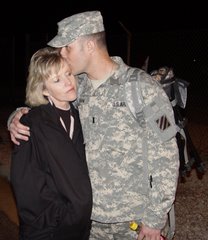
BAGHDAD --BY STEVEN R. HURST
Associated Press
October is on course to record the second consecutive decline in U.S. military and Iraqi civilian deaths and Americans commanders say they know why: the U.S. troop increase and an Iraqi groundswell against al-Qaida and Shiite militia extremists.
Maj. Gen. Rick Lynch points to what the military calls "Concerned Citizens" -- both Shiites and Sunnis who have joined the American fight. He says he's signed up 20,000 of them in the past four months.
"I've never been more optimistic than I am right now with the progress we've made in Iraq. The only people who are going to win this counterinsurgency project are the people of Iraq. We've said that all along. And now they're coming forward in masses," Lynch said in a recent interview at a U.S. base deep in hostile territory south of Baghdad. Outgoing artillery thundered as he spoke.
Lynch, who commands the 3rd Infantry Division and once served as the military spokesman in Baghdad, is a tireless cheerleader of the American effort in Iraq. But the death toll over the past two months appears to reinforce his optimism. The question, of course: Will it last?
As of Tuesday, the Pentagon has reported 28 U.S. military deaths in October. At the current pace, the monthly total will be about 37 or 38. That would be the lowest total since 31 in March 2006 and the second lowest monthly toll stretching back to February 2004, when 20 soldiers died.
In September, 65 U.S. soldiers died in Iraq.
Part of the trend can be seen in a volatile and violent band of lush agricultural land on Baghdad's southern border.
The commander of the battle zone -- Lt. Col. Val Keaveny, 3rd Battalion, 509th Infantry (Airborne) -- said his unit has lost only one soldier in the past four months despite intensified operations against both Shiite and Sunni extremists, including powerful al-Qaida in Iraq cells.
Keaveny attributes the startling decline to a decrease in attacks by militants who are being rounded up in big numbers on information provided by the citizen force -- which has literally doubled the number of eyes and ears available to the military.
The efforts to recruit local partners began taking shape earlier this year in the western province of Anbar, which had become the virtual heartland for Sunni insurgents and al-Qaida bands. The early successes in Anbar -- coming alongside a boost of 30,000 U.S. forces into the Baghdad area -- led to similar alliances in other parts of Iraq.
"People are fed up with fear, intimidation and being brutalized. Once they hit that tipping point, they're fed up, they come to realized we truly do provide them better hope for the future. What we're seeing now is the beginning of a snowball," said Keaveny, whose forces operate out of Forward Operating Base Kalsu, about 35 miles south of Baghdad.
While U.S. death figures appear to be in sharp decline, the number of Iraqi civilians and security forces show a less dramatic drop. And any significant attack -- by insurgents or civilians caught in the crossfire -- could quickly wipe out the downward trend.





No comments:
Post a Comment